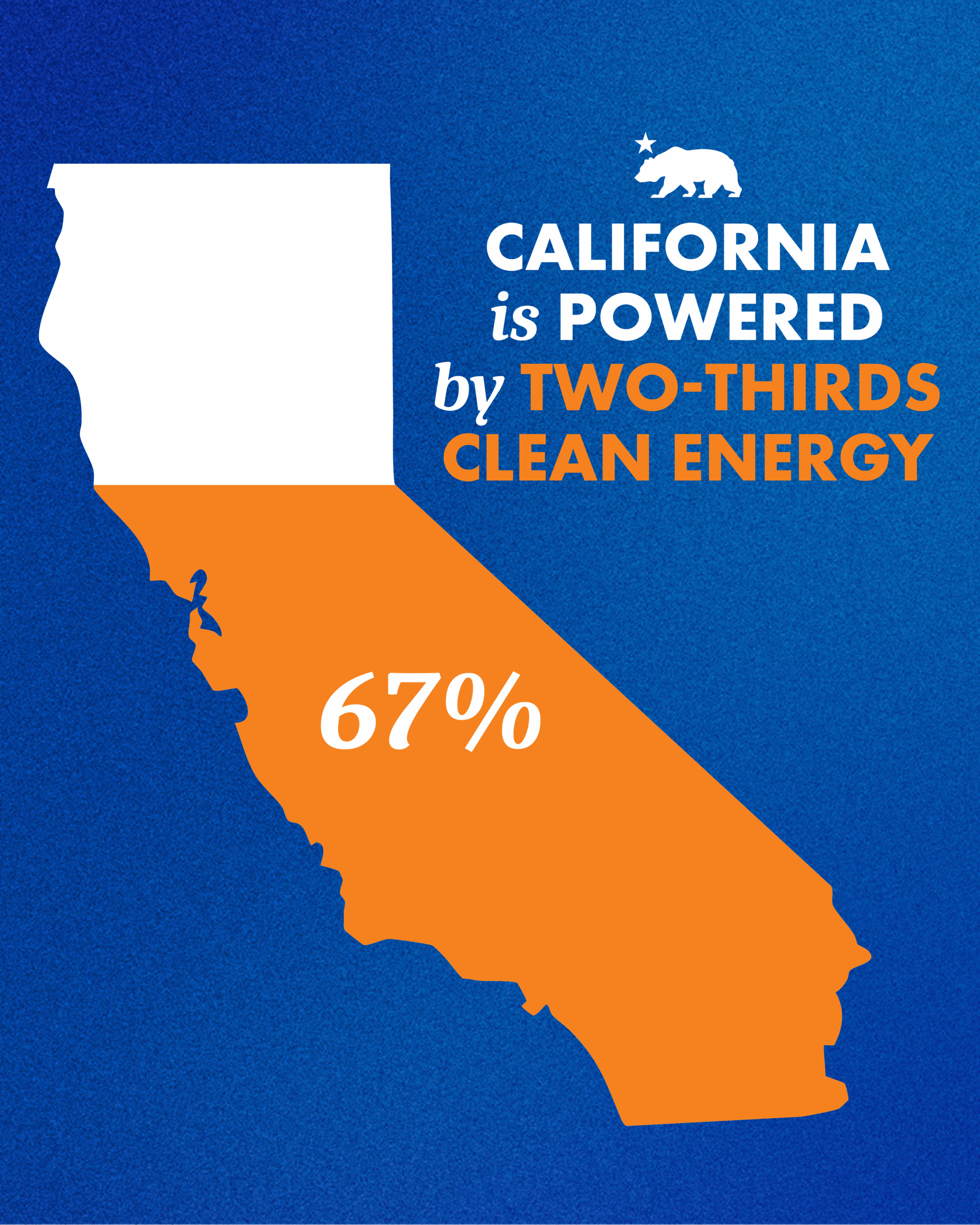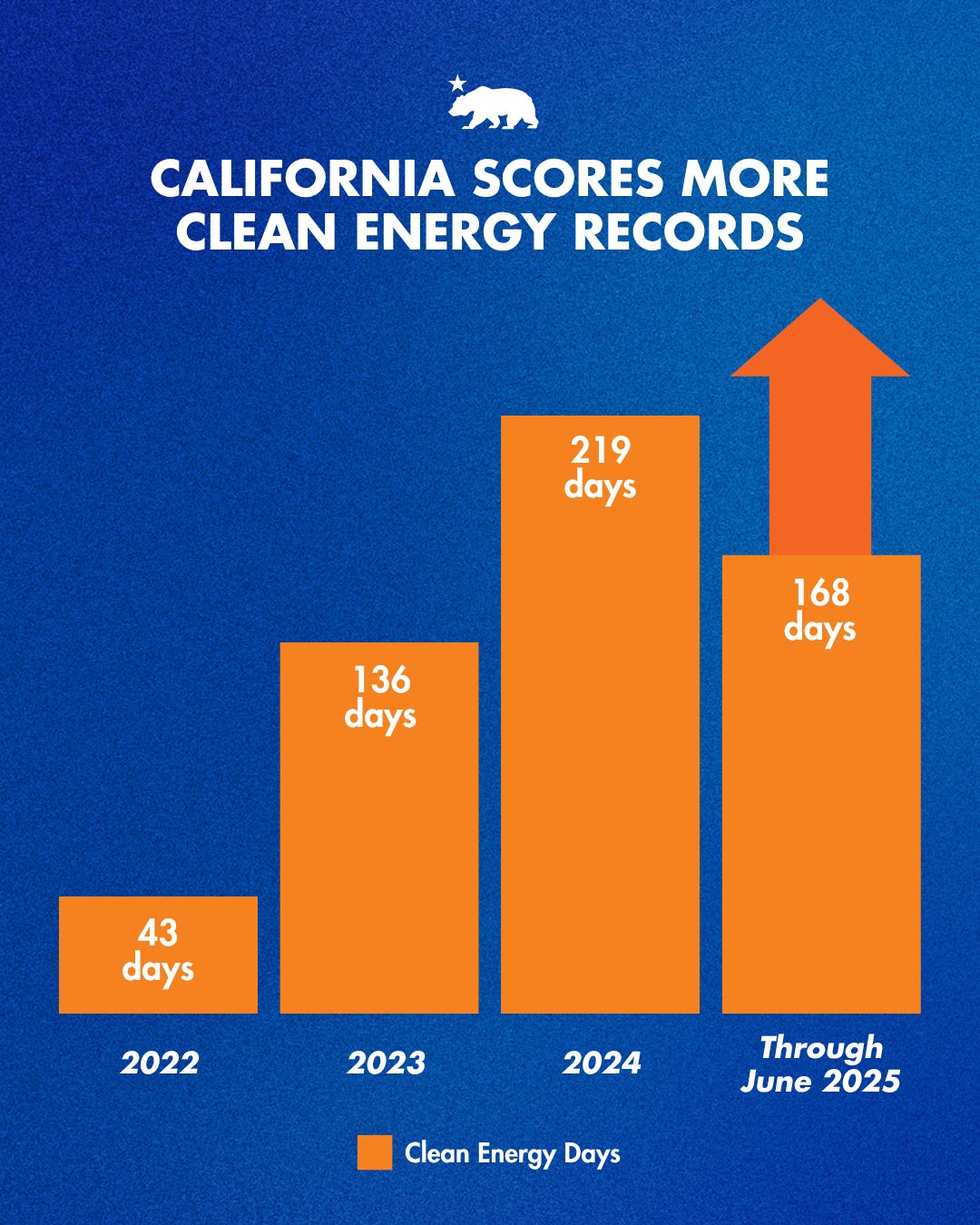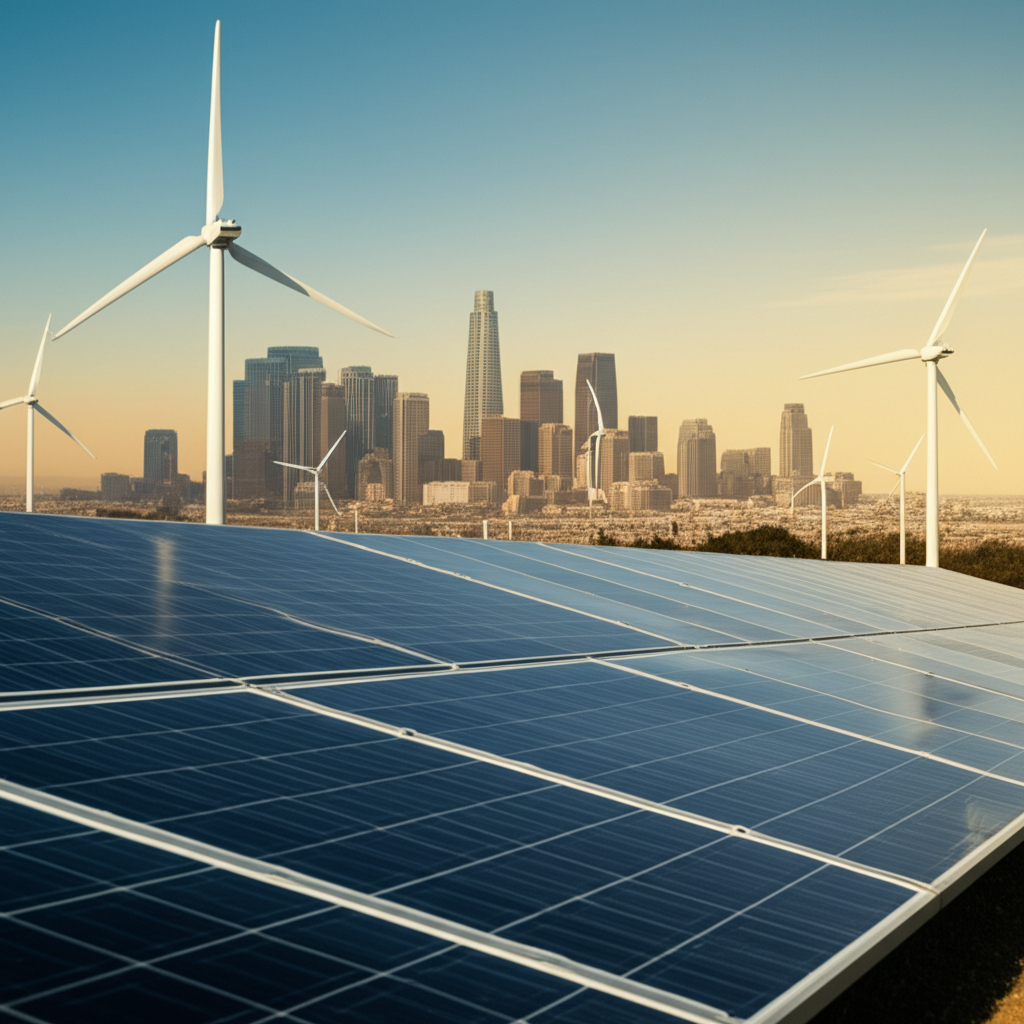California's Historic Leap: Powering the World's Largest Economy with Two-Thirds Clean Energy
In a landmark announcement that underscores the accelerating global shift towards sustainable power, California has revealed that two-thirds of its retail electricity sales in 2023 were powered by clean energy sources. This achievement positions the Golden State, the world's fourth-largest economy, as the largest economic entity globally to reach such a significant level of clean energy integration.
The data, released by state officials, highlights a remarkable trajectory of progress. Just a decade ago, in 2013, clean energy accounted for approximately 41% of California's power mix. By 2022, this figure had risen to 61%, and the jump to 67% in 2023 demonstrates an unprecedented pace of transition. Sources contributing to this clean energy mix include solar, wind, hydro, nuclear, geothermal, and biomass.
Governor Gavin Newsom lauded the milestone, stating, "As the federal government turns its back on innovation and commonsense, California is making our clean energy future a reality. The world’s fourth largest economy is running on two-thirds clean power – the largest economy on the planet to achieve this milestone." He also pointed to another significant indicator: for the first time ever, clean energy provided 100% of the state's power for some part of the day on nearly every day in 2025 so far, a feat he compared to the rapid transformation seen during the Industrial Revolution.
A Decade of Accelerated Growth and Investment
California's clean energy success is not an overnight phenomenon but the result of sustained policy commitments, technological innovation, and substantial investment over the past 15 years. These efforts have created a fertile ground for the rapid development and deployment of new clean energy generation and storage capacity.
The pace of growth has been particularly striking in recent years. In 2024, California added a record-breaking 7,000 megawatts (MW) of clean capacity to its grid. This figure surpasses the previous records set in 2022 and 2023, marking the third consecutive year of unprecedented expansion in clean energy infrastructure. Since 2019, a total of 25,000 MW of new energy resources, predominantly solar and battery storage, have been connected to the grid statewide. This aligns with the state's ambitious roadmap, released in 2023, which calls for a staggering 148,000 MW of new clean power by 2045 to meet its decarbonization targets.
David Hochschild, Chair of the California Energy Commission (CEC), commented on the achievement, saying, "California has achieved yet another major milestone on our journey to a clean energy future. The latest numbers show how our state is demonstrating that clean energy is mainstream and is here to stay."
The state's Renewable Portfolio Standard (RPS) has been a key policy driver. Sources eligible under the RPS, primarily solar and wind, constituted 43% of the power mix in 2023, up from 39% in 2022. Other zero-carbon resources, such as large hydro (12%) and nuclear power (12%), also played significant roles in achieving the 67% total.
Alice Reynolds, President of the California Public Utilities Commission (CPUC), highlighted the collaborative effort: "California has set ambitious clean energy goals, and utilities and community choice aggregators have stepped up to deliver clean resources at competitive prices to communities up and down the state. We are bringing renewable energy online at an unprecedented scale and pace never seen before."
Solar and Storage: The Pillars of California's Clean Grid
Among the various clean energy technologies, solar power stands out as the dominant force in California's transition. The state boasts over 21,000 MW of utility-scale solar capacity connected to the grid, complemented by another 19,000 MW of behind-the-meter generation (like rooftop solar). California's grid regularly sets new peak records for solar generation, with the latest peak exceeding 21,500 MW.
Crucially, the rapid expansion of solar power has been matched by an equally impressive surge in battery energy storage capacity. Energy storage is vital for integrating intermittent renewable sources like solar and wind, allowing excess energy generated during peak production times (e.g., midday sun) to be stored and dispatched when needed (e.g., during evening peak demand). California's battery fleet has grown exponentially, now exceeding 15,000 MW of capacity. This represents a staggering 1944% increase since Governor Newsom took office in 2019. This massive storage capacity is instrumental in stabilizing the grid and maximizing the use of renewable energy.

The Significance of 'Clean Energy Days'
The concept of 'clean energy days' provides another compelling metric of California's progress. So far in 2025, more than 9 out of 10 days have seen the state's grid powered by 100% clean energy for at least some portion of the day. On average, the grid has run on 100% clean electricity for about 7 hours daily this year.
Data compiled by the California Energy Commission indicates that clean energy has powered the equivalent of 51.9 full days year-to-date in 2025, representing nearly 30% of the year operating entirely on clean electricity. This figure already surpasses the total number of equivalent clean energy days in the entirety of 2024 and marks a remarkable 750% increase since 2022. While these periods of 100% clean power are often during times of high solar production and lower demand, they demonstrate the increasing capability of the grid to rely solely on clean sources, setting the stage for longer durations in the future.

Economic Prosperity and Environmental Gains
California's aggressive pursuit of clean energy has yielded significant environmental and economic benefits. As the grid becomes cleaner, greenhouse gas emissions have declined substantially. Since 2000, California's greenhouse gas emissions are down 20%, even as the state's Gross Domestic Product (GDP) has grown by an impressive 78% over the same period. The power sector has been a major contributor to this emissions reduction, cutting its emissions in half since 2009, helping the state meet its emissions reduction goals ahead of schedule.
Furthermore, California is home to the largest clean energy workforce in the United States. The state boasts over half a million green jobs, outnumbering fossil fuel jobs by a factor of seven. Solar and wind industries account for the majority of these positions, while the battery storage and grid modernization sectors represent the second-fastest-growing segment within California's clean energy workforce. This job growth spans manufacturing, installation, maintenance, research, and development, creating new economic opportunities across the state.
The Path Forward: Challenges and Opportunities
While reaching two-thirds clean energy is a monumental achievement, California's journey to a fully decarbonized grid by 2045 is not without its challenges. Integrating higher levels of intermittent renewables requires sophisticated grid management, advanced forecasting, and significant investments in transmission infrastructure to move power from generation sites (often remote) to demand centers.
Battery storage, while rapidly expanding, needs to continue growing to provide reliability during periods when solar and wind production are low. Long-duration storage solutions, beyond the typical 4-hour batteries, are also crucial for ensuring grid stability over days or even weeks. Permitting processes for new large-scale projects, both generation and transmission, can be complex and time-consuming, potentially slowing down the pace of deployment.
Ensuring grid reliability during extreme weather events, which are becoming more frequent due to climate change, is another critical challenge. This includes managing peak demand during heatwaves and protecting infrastructure from wildfires.
Despite these hurdles, the opportunities are immense. California's leadership in clean energy is driving innovation that has global implications. Investments continue to pour into the state's clean tech sector, fostering new technologies and business models. For instance, venture capital funding for energy storage companies and grid modernization startups remains robust, as highlighted by reports in publications like VentureBeat, which frequently covers investment trends in the clean energy sector. This private investment complements public funding and incentives, creating a powerful engine for growth.
Technological advancements are continuously improving the efficiency and cost-effectiveness of renewable energy. Solar panel efficiency is increasing, wind turbine technology is evolving to capture more energy, and battery costs are declining, making these technologies increasingly competitive with traditional fossil fuels. Articles in publications like Wired often delve into the technological innovations shaping the future of the grid, from advanced sensors and AI-powered forecasting to new materials for batteries and solar cells.
Furthermore, the expansion of offshore wind power along California's coast holds significant potential to provide a reliable source of clean energy, particularly during evening hours when solar production drops. While still in early stages compared to onshore renewables, offshore wind is a key component of the state's long-term strategy.
The transition also involves electrifying other sectors of the economy, such as transportation and buildings. As more electric vehicles hit the road and homes switch from natural gas to electric appliances, the demand on the grid will increase. Meeting this growing demand with clean energy is essential for achieving the state's overall climate goals. This requires not only more clean generation but also smart charging infrastructure and demand management strategies.
California's experience offers valuable lessons for other regions and nations embarking on similar energy transitions. The combination of ambitious policy targets, consistent investment, focus on technological innovation, and development of a skilled workforce has proven effective. The state's ability to integrate large amounts of variable renewable energy, supported by rapidly expanding storage, demonstrates a viable pathway to a high-renewables grid.
The economic benefits, particularly in job creation, provide a compelling argument for the green transition. As reported by sources covering the tech and business landscape, the growth in clean energy jobs in California is not just in installation but also in high-tech manufacturing, software development for grid management, and research. TechCrunch, for example, has covered the rise of clean tech startups in California, highlighting the entrepreneurial spirit driving innovation in this sector.
Looking ahead, California's commitment to reaching 100% clean electricity by 2045 remains firm. Achieving this final phase will require overcoming the remaining technical and economic challenges, including ensuring reliability during all hours of the year, managing seasonal variations in renewable output, and upgrading transmission and distribution infrastructure. It will also involve continued public and private sector collaboration and sustained public support.
The state's progress serves as a powerful example that deep decarbonization is possible even for large, complex economies. By demonstrating that significant emissions reductions can go hand-in-hand with robust economic growth and job creation, California is providing a blueprint for a sustainable and prosperous future.
The achievement of powering two-thirds of its grid with clean energy is more than just a number; it represents a fundamental transformation of California's energy landscape. It is a testament to the state's long-term vision, its willingness to invest in the future, and the ingenuity of its workforce and innovators. As the state continues its journey towards 100% clean energy, its experiences will undoubtedly continue to inform and inspire similar transitions around the world.
The rapid deployment of battery storage is particularly noteworthy. The nearly 20-fold increase in capacity since 2019 has fundamentally changed the grid's ability to manage renewable variability. This growth is expected to continue, with new projects constantly coming online. VentureBeat has reported on the technological breakthroughs and market dynamics driving this explosive growth in battery storage, highlighting the role of startups and established companies alike.
Furthermore, the policy environment in California continues to evolve to support the clean energy transition. State agencies like the CEC and CPUC are constantly working on new regulations, incentives, and planning processes to facilitate the integration of renewables, storage, and distributed energy resources. This includes streamlining permitting, updating interconnection rules, and designing market mechanisms that properly value clean energy and grid flexibility.
The focus is not just on utility-scale projects. Rooftop solar, supported by policies like net metering (though subject to ongoing adjustments), has empowered millions of Californians to generate their own clean energy, contributing significantly to the overall clean energy mix. Integrating this distributed generation effectively into the grid is a complex but essential task.
California's commitment extends beyond electricity generation to encompass the broader energy system. Policies promoting electric vehicles, charging infrastructure, and building electrification are designed to shift energy demand away from fossil fuels towards the increasingly clean grid. This integrated approach is crucial for achieving the state's economy-wide decarbonization goals.
The state's experience also highlights the importance of public engagement and equity in the energy transition. Ensuring that the benefits of clean energy, such as cleaner air and lower energy costs, are shared equitably across all communities, including low-income and disadvantaged areas, is a key priority. Policies are being developed to support clean energy access and job training in these communities.
California's journey is a dynamic process, facing ongoing challenges related to grid reliability, cost management, and the need for continuous innovation. However, the progress made to date, culminating in the achievement of two-thirds clean energy, demonstrates the state's capacity to drive transformative change on a massive scale. It serves as a powerful case study for policymakers, technologists, and investors globally, illustrating that a rapid transition to a clean energy future is not only environmentally necessary but also economically beneficial.
As the state continues to push towards its 2045 target, the lessons learned from its successes and challenges will be invaluable for the global effort to combat climate change and build a sustainable energy future. The milestone of reaching two-thirds clean energy is a significant step, affirming California's position as a leader in the global clean energy revolution.
The role of technology in this transition cannot be overstated. From advanced inverters and grid software to new materials for solar panels and batteries, innovation is at the heart of California's success. Publications like Wired often explore the cutting-edge technologies enabling this transformation, highlighting how software and hardware are working together to create a more resilient and cleaner grid.
Furthermore, the financial sector's increasing focus on ESG (Environmental, Social, and Governance) criteria is driving more investment into clean energy projects. VentureBeat has covered how ESG trends are influencing clean energy finance, making projects in states like California particularly attractive to investors seeking sustainable opportunities.
The state's commitment to research and development, often in collaboration with its world-renowned universities and research institutions, is also a critical factor. This focus on innovation ensures that California remains at the forefront of clean energy technology and policy development.
In conclusion, California's achievement of powering two-thirds of its economy with clean energy is a historic moment. It is a testament to the power of ambitious goals, sustained investment, technological innovation, and a dedicated workforce. While the path to 100% clean energy presents further challenges, the progress made demonstrates that a rapid, large-scale energy transition is not only feasible but also brings significant environmental and economic benefits. California continues to lead the way, providing a compelling model for a cleaner, more sustainable future.
The state's experience with integrating variable renewables and managing grid stability is particularly relevant globally. As more regions adopt solar and wind power, the need for effective storage and grid management solutions becomes paramount. TechCrunch has highlighted companies developing innovative grid management solutions, many of which are based in or operating in California, addressing these very challenges.
This milestone reinforces the narrative that climate action and economic growth are not mutually exclusive but can be mutually reinforcing. California's success story provides a powerful counterpoint to arguments that transitioning to clean energy will harm the economy. Instead, it shows that it can be a driver of new industries, jobs, and prosperity.
The state's ongoing efforts to modernize its grid, including deploying smart grid technologies and enhancing cybersecurity, are also critical components of its clean energy future. A reliable and secure grid is essential to support the increasing reliance on distributed and variable resources.
Finally, the policy landscape will continue to play a crucial role. Maintaining consistent policy signals, adapting regulations to new technologies, and ensuring market structures support clean energy deployment are essential for continued progress towards the 2045 goal. California's legislative and regulatory bodies remain actively engaged in shaping this future.
California's achievement is a beacon of hope and a practical demonstration of what is possible when a large economy commits to a clean energy future. It sets a new benchmark for others to follow and accelerates the global momentum towards a sustainable energy system.
